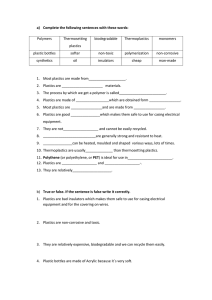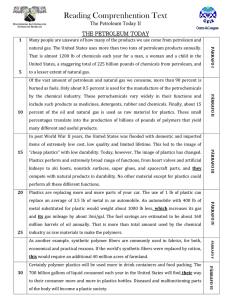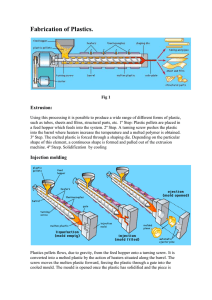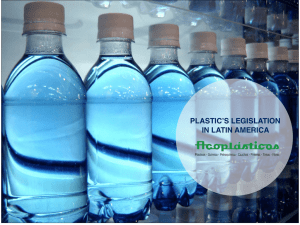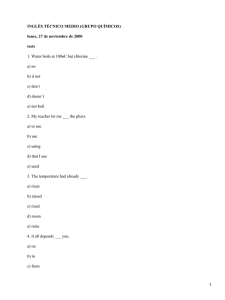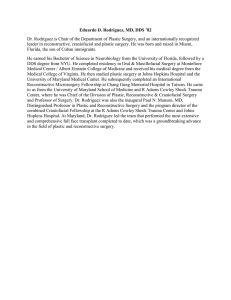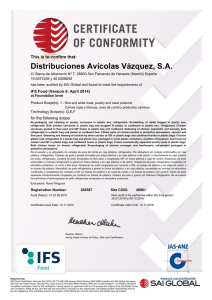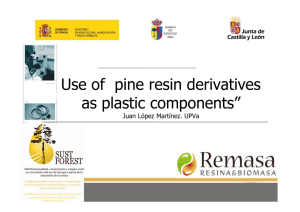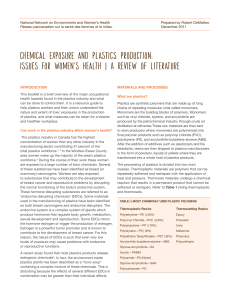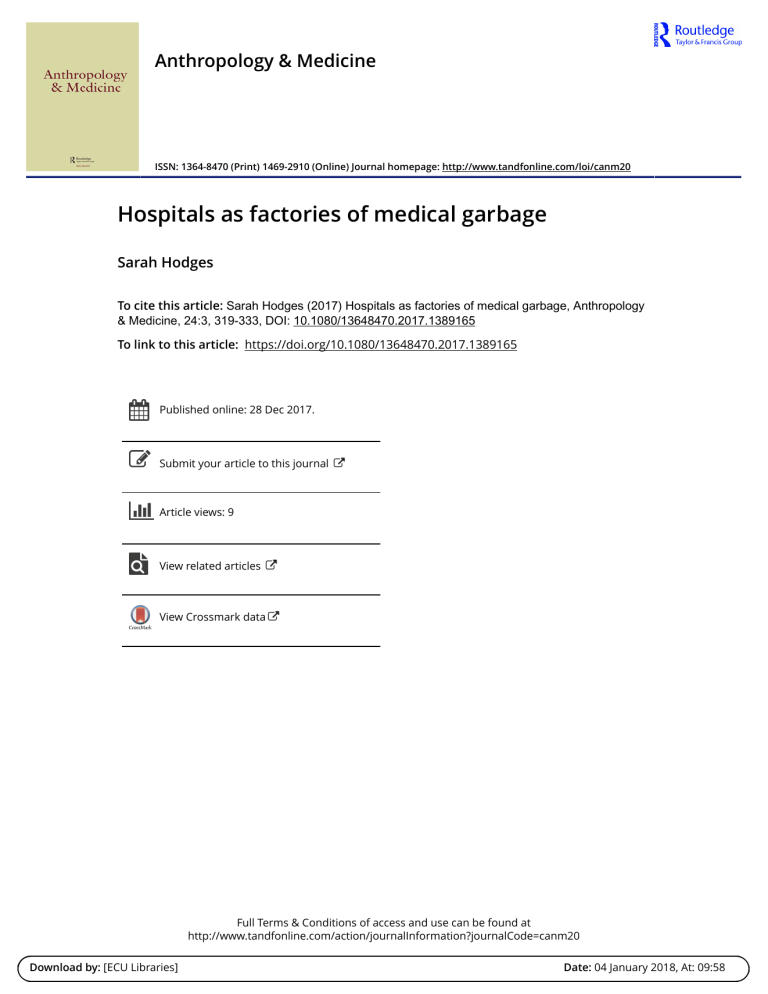
Anthropology & Medicine ISSN: 1364-8470 (Print) 1469-2910 (Online) Journal homepage: http://www.tandfonline.com/loi/canm20 Hospitals as factories of medical garbage Sarah Hodges To cite this article: Sarah Hodges (2017) Hospitals as factories of medical garbage, Anthropology & Medicine, 24:3, 319-333, DOI: 10.1080/13648470.2017.1389165 To link to this article: https://doi.org/10.1080/13648470.2017.1389165 Published online: 28 Dec 2017. Submit your article to this journal Article views: 9 View related articles View Crossmark data Full Terms & Conditions of access and use can be found at http://www.tandfonline.com/action/journalInformation?journalCode=canm20 Download by: [ECU Libraries] Date: 04 January 2018, At: 09:58 ANTHROPOLOGY & MEDICINE, 2017 VOL. 24, NO. 3, 319–333 https://doi.org/10.1080/13648470.2017.1389165 Hospitals as factories of medical garbage Sarah Hodges Downloaded by [ECU Libraries] at 09:58 04 January 2018 History Department, University of Warwick, Coventry, UK ABSTRACT ARTICLE HISTORY Over the course of the twentieth century, as hospitals cleaned up, they came to produce more and more rubbish. Beginning in the 1970s and gaining pace in the 1980s and 1990s, single-use plastic items (syringes, blood bags, tubing) saturated everyday medical practice across the globe. This essay brings the question of plastic to bear upon the longer history of twentieth century sanitary science. The widespread adoption of single-use disposable medical plastics consolidated a century’s worth of changes in medical hygiene. As strange as it may seem today, the initial uptake of medical plastics was not driven primarily by concerns about hygiene. Plastic began as a mid-century technology of convenience and durability. It was not until the end of the twentieth century that it morphed into a powerful symbol and instrument of medical hygiene. Today, both patients and practitioners have embraced plastic as an indispensable technology of clean medicine. The procession of single-use medical plastics through everyday medicine now comprises a constant, if disposable, infrastructure of medical hygiene. This new processional infrastructure of disposable hygiene has produced another, albeit unintended, consequence. This new regime has exponentially increased hospitals’ material outputs. In so doing, plastic has refigured the ecologies of everyday medicine. Plastic hygiene has rendered hospitals factories of medical garbage. Received 29 March 2017 Accepted 29 May 2017 KEYWORDS Garbage; plastic; hygiene; disposable; infrastructure; medicine Introduction Over the course of the twentieth century, as hospitals cleaned up, they came to produce more and more rubbish. Beginning in the 1970s and gaining pace in the 1980s and 1990s, single-use plastic items (syringes, blood bags, tubing) saturated everyday medical practice across the globe. This essay brings the question of plastic to bear upon the longer history of twentieth century sanitary science. The widespread adoption of single-use disposable medical plastics consolidated a century’s worth of changes in medical hygiene. As strange as it may seem today, the initial uptake of medical plastics was not driven primarily by concerns about hygiene. Plastic began as a mid-century technology of convenience and durability. It was not until the end of the twentieth century that it morphed into a powerful symbol and instrument of medical hygiene. Today, both patients and practitioners have embraced plastic as an indispensable technology of clean medicine. The procession CONTACT Sarah Hodges [email protected] © 2017 Informa UK Limited, trading as Taylor & Francis Group 320 S. HODGES of single-use medical plastics through everyday medicine now comprises a constant, if disposable, infrastructure of medical hygiene. This new processional infrastructure of disposable hygiene has produced another, albeit unintended, consequence. This new regime has exponentially increased hospitals’ material outputs. In so doing, plastic has refigured the ecologies of everyday medicine. Plastic hygiene has rendered hospitals factories of medical garbage. Downloaded by [ECU Libraries] at 09:58 04 January 2018 Modern medicine and modern hygiene Although hospitals produce many kinds of trash, by the close of the twentieth century, hospital bins came to hold a staggering amount of plastic (Patil and Shekdar 2001; Pr€ uss, Giroult, and Ruskbrook 1999; Taneja and Biswal 2006; Verma et al. 2008). Indeed, after general waste (food, and other things we might recognize as domestic waste), by volume, used, discarded medical plastics typically now constitute the lion’s share of specialist medical garbage pumped out every day by hospitals and clinics (Daschner and Dettenkofer 1997; Note on Biomedical Wastes Management 2005; Patil and Shekdar 2001). Yet this state of affairs is relatively recent. In this section, I situate the widespread uptake of singleuse sterilized disposable medical plastics within the longer history of modern sanitary science. I do this in order to ask: Did plastics provide a new answer to the old problem of medical hygiene? Or, did plastic simply provide a new material with which to enact existing hygienic theories and practices? The late nineteenth and early twentieth centuries hold pride of place for the history of modern sanitary science. Throughout much of the nineteenth century, modern medicine had relied on a set of popular and expert principles of what its adherents referred to as ‘cleanliness’ (Bashford 1998). However, as medical practitioners in Britain and Germany, for example, became bolder in opening up the body to effect treatment, they increasingly faced the problem of losing their patients to post-operative infection (Schlich 2012, 2013). ‘Cleanliness’ came under new critical scrutiny, particularly by surgeons. Nevertheless, during these decades, medical experts rarely agreed on the best way to protect in-patients from post-operative infection, fatal or otherwise. By the late nineteenth century, some surgeons advocated antiseptics, such as carbolic acid, to kill germs during invasive treatment and recovery. Other surgeons instead advocated asepsis – a set of that practices, such as sterilization of instruments, that sought to avoid germs in the first place (Schlich 2013; Fox 1988). Many adopted a combination of the two. Broadly speaking, over the last few decades, historians have analysed these changes in practices of medical hygiene – whether antiseptic, aseptic or both – by situating them alongside the emergence of the field of bacteriology and its corollary, germ theory (Worboys 2000). This work has showed that the relationship between medical hygiene and advances in bacteriology was far less straightforward than early accounts portrayed (Pennington 1995). In attempting to make sense of how germ theory informed therapeutic practice in Europe over the course of the late nineteenth and early twentieth centuries, many historians have noted a puzzling disconnect between published scientific research, medical practice and popular belief (Bashford 1998; Fox 1988; Granshaw 1992; Lawrence and Dixey 1992; Pennington 1995; Schlich 2007, 2012, 2013; Tomes 1998; Worboys 2000). Despite turn-of-the-century surgeons’ debate that pit antiseptic practice against Downloaded by [ECU Libraries] at 09:58 04 January 2018 ANTHROPOLOGY & MEDICINE 321 aseptic practice, these historians note that broader changes in hygienic practices often happened in the absence of practitioners’ professing corollary conceptual changes in thinking about disease and illness. Historians have also asked questions about the relationships between the spread of germ theory and changes in technologies of hygiene. These accounts have examined changes in the material practices of hygiene, such as the uptake of surgical gloves and gowns or changes in operating room design (Schlich 2007, 2013). This work, too, reminds us how the appearance of new items that we may today regard as central to medical hygiene often emerged in the absence of a unifying theory supporting their adoption. This longer history of sanitary science matters to the contemporary history of medical hygiene because this scholarship suggests that there is much to be gained by querying the connections – or lack thereof – between material practice and biomedical theory. In short, we now know that meant at the turn of the twentieth century was heavily contested. We also know that there was not a clear pattern of how the changing understandings of germs animated both medical and domestic hygienic practices (Bashford 1998; Tomes 1998). In short, the history of modern sanitary science is full of examples of everyday hygienic practices that became widespread despite being poorly aligned with scientific principles. Considering the contemporary history of medical plastics helps to illuminate how the longer history of medical hygiene can be told as a story of how earlier attention to the hygiene of spaces gave way to a vigilance surrounding the sterile status of particular objects. In his account of the history of surgical gloves at the turn of the twentieth century, for example, Schlich (2013) tells the story of their uptake – or eschewal – as freighted with the weight of the germ theory debate. Thinking with Schlich’s work, the corollary question presents itself: If medical plastics now exist as both symbol and instrument of medical hygiene, does the plastic infusion of medical practice offer a similarly contentious story of the politics of medical progress? The arrival of plastic within everyday medical practice The extraordinary amount of plastic to be found in hospital bins today is but one outcome of the infusion of all arenas of everyday life by plastic over the course of the second half of the twentieth century. Accounts of the history of plastic tell us that only after about 1940 did plastic items start to be manufactured with any regularity. For the most part, these were for specialist industrial uses (Freinkel 2011; Meikle 1997). The 1950s and 1960s saw great expansion and innovation within chemical engineering – including for plastic. By the 1960s, new methods of manufacture meant that new kinds of plastics entered many areas of everyday life, including medicine (Collantine 1962; Soltis 1959; Federal Drug Administration 2000). Yet, the spread of plastics picked up speed and, by the 1990s, plastic had achieved a near ubiquitous status in most places across the globe (Edwards and Kellett 2000). Today, it would be unusual, if not impossible, to spend an entire day without handling any object containing plastic. The uptake of plastics within medical practice across the second half of the twentieth century follows a very similar trajectory to this broader uptake of plastics across all areas of daily life. By the 1950s, and particularly during the 1960s, innovations in medical practice saw a corollary emergence and marketing of new plastic medical devices. The Downloaded by [ECU Libraries] at 09:58 04 January 2018 322 S. HODGES paradigmatic example of this is the plastic syringe and its symbiotic relationship to new vaccines. Initially, the Salk polio vaccine was only available through injections (polio drops were not introduced until the 1960s through the Sabin vaccine). In 1955, the same year that the Salk injectable polio vaccine was launched, a plastic single-use syringe came onto the market (Pr€ uss, Giroult, and Ruskbrook 1999). Emphasizing durability, manufacturers promoted plastic syringes over glass as the best way to tackle the challenge of delivering huge numbers of doses of polio vaccine across widespread areas (Bellis 2016). Other plastic manufacturers soon followed suit in developing their own single-use plastic syringes (Modern Plastics 1957, 1969). Plastics also had a notably early entry into battlefield medicine. For example, plastic bags replaced glass bottles for transporting and administering blood. These new blood bags were used by US forces throughout the Korean War (1950–1953) (Freinkel 2011, 2610; Ausman and Bellamy 1984; Lemelson-MIT n.d.). As with mass vaccination drives, the appeal of plastics in battlefield medicine was largely due to their relative durability compared to glass. By the 1980s, disposable plastics were found in most areas of medical practice, particularly in high-resource settings. Over the past few years, my query to all clinician friends within earshot trained in the developed world – ‘When do you first recall using disposables?’ – has been met with indignant replies such as this one: ‘I’ve always used disposables. How old do you think I am?!’ Yet, the uptake of plastics was neither uniform nor inevitable. As with the history of vaccine delivery and battlefield medicine, medical plastics were not initially embraced by general practitioners due to plastics’ hygienic properties. Instead, medical plastics were initially marketed by manufacturers and praised by practitioners on the basis of their relative durability, ease of use and patient comfort (Griffenhagen and Bogard 1999). In my recent conversations with retired British clinicians, for example, they recalled their relief at the arrival of disposable plastic syringes. They noted that disposables were more reliable to use and far more comfortable for patients. This was particularly compared to the glass and metal equipment with which they were initially trained with to draw blood (Physician 1, personal communication, October 2016; Physician 2, personal communication, October 2016). During the second half of the twentieth century, new work in chemicals processing made a key change for the possibilities of plastic (Kinnane 2002). In particular, the development of new plastics and new methods of processing meant that new possibilities emerged for using plastics in sterile settings. During this time, chemical sterilization replaced steam sterilization in much industrial manufacture and packaging of medical items. This meant that heat-sensitive materials, like plastic, which earlier might have melted, could now be sterilized by the application of chemicals. Other kinds of plastics were produced that could withstand high temperatures. Alongside these developments specific to medical practice, disposable plastics – and many everyday products marketed as ‘disposable’ – were part of a larger trend. This 1980s trend saw manufacturers promote their newly ‘disposable’ products as possessing the linked virtues of hygiene and singleuse as a modern technology of hygiene rather than simply convenient (Freinkel 2011; Heinrich and Batchelor 2004; Lucas 2002; Meikle 1997; Smith 2007; Vinikas 1992). These disposable plastic medical items were not simply messengers of convenience; they were ambassadors of modern hygiene. ANTHROPOLOGY & MEDICINE 323 Downloaded by [ECU Libraries] at 09:58 04 January 2018 A different arrival: medical plastics in India The milestones and patterns of meanings narrated above come from what health economists call ‘high resource settings.’ Were these replicated world over? Certainly not. The case of India provides a story of a very different arrival for medical plastics. Beginning in the early 1970s, medical plastic imports to India began to increase. During these decades, for example, importers regularly advertised their wares in major national newspapers such as the Times of India. The 1970s saw an increase in plastics manufacture in India, including in areas such as pharmaceutical packaging, as India embarked upon a robust policy to become self-sufficient in pharmaceutical manufacturing (Times of India 1970). Disposable plastic syringes represented the vanguard of the medical plastic’s arrival to India. As part of the World Health Organization’s Expanded Programme of Immunisation in India, the first big arrival of disposables was in 1978. In response, as with the history of polio immunization in the USA, from the late 1970s Indian manufacturers began to put a larger range of disposable medical plastics onto the domestic market (Times of India 1978). Yet, one former clinician’s recollections suggest that this did not, in and of itself, create a sea change: ‘I’ve not been in clinical medicine in years and years, since 1980, when we hardly had any disposables.’1 It was only after the roll-out of the Universal Immunisation Programme later in the 1980s that disposable syringes began to be used in India in any significant number (Nichter and Van Sickle 2002; Times of India 1983), and Hindustan Syringes & Medical Devices, Ltd., Asia’s largest syringe manufacturing company, started manufacturing disposable syringes and needles in India in the years immediately following the introduction of Universal Immunization Programme (UIP) (Hindustan Medical Devices 2014). Nevertheless, despite these beginnings, popular memory among Indian patients and practitioners points to the 1990s as the decade of increased use of disposable plastic syringes within India. This is not only to be seen in my interviews with physicians; a few telling reports made their way into the press. In 1992, the Times of India reported a case of a woman in Mumbai who had complained about a visit to a doctor there for vaccinations in advance of travel overseas. The paper reported: When her turn came, [the woman] said, she insisted upon the dosage of vaccine being drawn and filled anew in a disposable syringe as a precaution against the danger of being infected, not excluding from the HIV virus. Rejecting the request, the doctor is alleged to have behaved in a most ‘undoctor-like’ manner towards the woman traveler. (Times of India 1992) Such tales of patient anxiety – and demand – were not unusual in the late 1980s and 1990s (Patient 1, personal communication, July 1988). In the late 1980s and particularly by the early 1990s, India had been identified as a hotbed of new AIDS cases (Kanagawa, forthcoming). Organizations like UNAIDS feared that India would become another country with a very high prevalence rate of infection (Engel 2006). As a result, during the 1990s, India’s public health institutions as well as the popular media significantly raised popular awareness about AIDS and its transmission. This changed both patient expectations (as above) and physicians’ practices (Van Hollen 2013). Global disease landscapes and the making of plastic as ambassador of hygiene In high resource settings, the uptake of single-use disposable medical plastic items initially revolved around convenience rather than urgency. In contrast, in India, a health care Downloaded by [ECU Libraries] at 09:58 04 January 2018 324 S. HODGES setting without robust infrastructures (such as a regular power supply and clean water), medical plastics were initially promoted because the technology of packaged sterility allowed for the delivery of development projects like vaccination. By the close of the twentieth century, despite medical plastic’s multiple beginnings – technology of patient comfort, technology facilitating practitioner ease, technology of battlefield medicine and messenger of international development – a new, and dominant, meaning emerged for medical plastic. Across the globe, medical plastic came to be popularly recognized as both symbol and instrument of medical hygiene. Although this meaning to ambassador of hygiene has today become commonsensical, it was neither natural nor inevitable. During the second half of the twentieth century, therapeutic advances such as antibiotics allowed practitioners to control many post-operative and other infections. Yet, crossinfection – infections acquired in hospitals in spite of modern regimes of hygiene – remained a great challenge. By the 1960s and particularly over the course of the 1970s, cross-infection was significant enough to merit a new subfield, ‘infection control.’ By the 1960s and 1970s, infection control specialists found themselves confronted with a seemingly limitless set of hygienic battlegrounds in their attempts to understand – and their corollary attempts to control – infections and cross infections in clinical settings. Yet, much hospital infection scholarship of those decades was infused by a Sisyphean weariness (e.g. Ayliffe 1980). Throughout publications like the Journal of Hospital Infection, time and again, researchers’ findings suggested that, whilst floor scrubbing with disinfectants was substantially more effective at removing bacteria and other potential infection causing agents, the nature of the clinical space was such that even were all the infection causing agents to be removed from the floors daily, it would inevitably be replaced by the entrance of new ones, almost immediately.2 Within this expanding horizon, whither any hope for hospital hygiene? Further, by the 1980s, the global disease climate changed (National Institutes of Health 2007). Antibiotics, for example, had initially been hailed as tools to vanquish infection. However, as drug-resistant bacteria appeared, these and other drugs came to be seen as double-edged swords (Gradmann 2016). Childhood diseases and other infectious killers thought to be ‘on the way out’, such as tuberculosis and malaria, re-emerged (Farmer 1999; Garrett 1994, 2000). Over the course of the final decades of the twentieth century, these resurgent diseases were joined by newly emerging diseases such as AIDS, Ebola and SARS. The concomitant boom in long haul air travel also redrew boundaries of infective vulnerability (Abraham 2005; Fidler 2004). The spread of AIDS in particular commanded the attention of practitioners and patients. Although the AIDS virus was, comparatively speaking, very difficult to ‘catch’ in clinical settings, AIDS sharpened an urgency to ‘do something’ to address a collective sense of renewed vulnerability to infection (Schaffner 1988; Tomes 1998). Many, within both biomedical research and emergency management, sat in anticipation of the next global pandemic (Caduff 2015). In short, the disease climate of the late twentieth century shone renewed light on the long-standing problem of how to guard against infective dangers – whether on hospital wards or in daily life. During these decades, single-use disposable medical plastics, in and of themselves, were not a new technology. Indeed, by the 1990s, when claims about the relative hygienic properties of single-use disposable medical plastics became widespread, medical plastic in many national medical settings was already ubiquitous, or nearly so. Yet within this new emotive disease ecology, new meanings attached to plastics, which rendered them as ANTHROPOLOGY & MEDICINE 325 Downloaded by [ECU Libraries] at 09:58 04 January 2018 delivering new kind of hygienic technology. As new-found ambassadors of hygiene from the 1990s onwards, single-use disposable plastics rekindled, recalibrated and reconnected older anxieties about contagion and vulnerability with experts’ case for renewed attention to basic medical hygiene (Fox 1988; Schlich 2012; Tomes 1998; Worboys 2000). In short, the history of medical plastic – and sanitary science more generally – is a story of how big changes in modern hygienic practice have rarely been driven primarily by ‘science’ (or anything that might be measurable in a laboratory). Single-use disposable plastic items were not initially incorporated into medical practice for the purposes of guarding against hospital infection and cross infection. Instead, during a period of heightened uncertainty and infective vulnerability, plastics – and their promise of packaged sterility – came to be seen by clinical staff and the patient public as fundamental to good clinical practice. Hygiene’s plastic infrastructure and the question of unanticipated consequences Popular and professional common sense continues to frame the uptake of medical plastics as part of a longer history of a clinical march towards medical hygiene. This is despite study after study finding that hand washing with soap remains a far more effective way to guard against hospital-based infection and cross infection (e.g. Centres for Disease Control and Prevention 2015). In light of this, perhaps the popular and professional embrace of single-use medical plastic objects as necessary ambassadors of hygiene is simply a benign misrecognition. Surely, the upshot is still the production of clean medicine. In this section of the essay, I want to revisit the question of what everyday medicine’s embrace of plastic hygiene has produced. Early on in this essay, I claimed that as medicine cleaned up, it created more and more rubbish. This story turns on medicine’s adoption of the single-use disposable plastic items. In this sense, the material impact of the large-scale uptake of plastics within medical practice has been nothing short of transformational. This uptake of plastics did two things. First, it transformed the infrastructure of hygiene for everyday medical practice. This new disposable regime of medical hygiene produced a plastic infrastructure. Comprised of single-use disposable plastic items, this new infrastructure was temporally and materially distinct from what had come before. Rather than cleaning and reusing durable items, plastic hygiene could only succeed through maintaining a discipline of constant renewal. Although this was similar to an earlier regime of cleaning durable items, it differed in one important way. Plastic hygiene also demanded a rigid adherence to the ephemerality of the items through which hygiene itself was delivered. In short, within everyday medical practice, the uptake of plastic came to constitute a new infrastructure, built on a permanent flow of temporary objects. Most broadly defined, ‘infrastructures’ are the physical networks through which goods, ideas, waste, power, people and finance are trafficked (Larkin 2013). Recently, the question of infrastructure – what it is, what it does and why it matters – has received renewed scholarly attention (e.g. Amin 2014; Graham and McFarlane 2014; Larkin 2013). For example, Amin (2014) ponders the conundrum of how it could be that so many people live in settlements that exist as simultaneously settled and illegal, unofficial and thereby temporary. Amin asks: What is the significance of the fact that the idea of settlement itself Downloaded by [ECU Libraries] at 09:58 04 January 2018 326 S. HODGES has become deeply un-settled? Amin answers this question by problematizing conventional understandings of infrastructure. In short, Amin and others point to how conventional understandings of infrastructure have proved inadequate to describe infrastructural practices as they actually exist in much of the world. Rather than define infrastructure through the normative landmarks of pylons and pipes, Amin’s work examines actually existing networks of distribution. Pylons and pipes are made and re-made, goods and services are routed and re-routed. In his tellings, the solidity of infrastructure becomes pliable – and indeed fragile. How could such a state of affairs have come to be, where the non-normativity of actually existing infrastructural practice destabilizes conventional meanings for the term ‘infrastructure’? Amin and others situate the overwhelming examples of non-normative infrastructure as historical products of development failure. The vast majority of examples on which Amin and others draw are located in what was once (and sometimes still is) referred to as the ‘developing world.’ In the Indian context, new critical work on the question of infrastructure has given special attention to the Hindi/Urdu term jugaad (or jugaar) (Rai, Saigal, and Thorat 2015). Jugaad translates as ‘hack’, improvisation, work-around or innovation. As Rai (2015) and others show, jugaad is useful for capturing both the historical and everyday dynamics of non-normative infrastructural forms. This is because, in colloquial usage, the term can do two things simultaneously. Jugaad can be both a noun and a verb; the cause and its effect. For example, if a state is not providing electricity to an illegal settlement, the jerry-rigging of wires that connect dwellings to the electricity mains is ‘jugaad.’ In other words, jugaad can be used to refer to the conditions for the production of non-normative infrastructures – in the example above, this could be the lack of development planning for the provision of housing. Jugaad can also be used to refer to the improvised material infrastructures that people produced in response to these development failures – in this case, the jerry-rigging of wires to deliver power to these dwellings. The key idea here is that the term ‘jugaad’ can be used to capture the idea of how work-arounds, or infrastructural hacks, both overcome development failures just as they enable them. The jerry-rigging of a power supply can override the need for residents in illegal settlements to demand effective services – in this case, access to electricity and/or access to affordable housing. Jugaad enables everyday life and livelihoods to carry on, despite development failures. What was at stake in the arrival of medical plastic as both symbol of and instrument for the distribution of medical hygiene? Thinking with the frameworks provided by new scholarship on infrastructure and jugaad, we can see how a new plastic infrastructure of hygiene has held a range of meanings, depending on when and where it has been implemented. Larkin argues that the broader meaning of infrastructural systems is not self-evident; they are entangled with other registers of meaning. Indeed, the promise and provision of infrastructures across much of the world has been intimately caught up with the sense of shaping modern society and realizing the future (Larkin 2013, 331–332). This observation is useful to think about in relation to the history of development failure in the production of contemporary non-normative infrastructural forms. In this reading, the uptake of single-use disposable plastics within India complicated India’s development story of medical modernity. In low resource settings such as India, medical plastics delivered pre-packaged modernity. The broader colonial semantics that connected medical progress to technological change bear considering (Arnold 2013). In Downloaded by [ECU Libraries] at 09:58 04 January 2018 ANTHROPOLOGY & MEDICINE 327 this reading, the uptake of single-use items fits as yet another example in a long list of high modernist infrastructural and technological ‘fixes’ that dominated development projects in India and elsewhere during the second half of the twentieth century. In this telling, single-use medical plastics served as both symbol and instrument for the medical version of ‘catching up’ with the West. Yet, insofar as plastics served as a fix to address infrastructural failure, medical plastics are also a trickster figure. They are both ambassador of hygienic progress whilst also serving as an object lesson: steady electricity and clean water are not necessary preconditions for pockets of medical sterility. In high resource settings, plastics became hygiene in the wake of a re-emergence of old diseases and the emergence of new ones. Such epidemiological circumstances stand in open defiance of and as rebuke to a conventional development narrative of ‘progress’ as it emerged over the course of the second half of the twentieth century. In short, the new hygienic infrastructure of plastic articulated the fundamental unsteadiness and fragility of a ‘modernity effect’ across the globe (Street 2012). The large-scale adoption of single-use disposable plastics within contemporary health care across the globe effected a technological standardization of medical hygiene. In health care settings with uneven or lacking infrastructure (such as a regular electricity supply or safe water), this standardization meant a kind of levelling-up. The use of single-use disposable plastics allowed targeted health care interventions – such as vaccination drives – to go ahead. This was despite a lack of uniform infrastructure – itself considered a precondition for broader gains in public health outcomes. Looking back, it now appears that plastic facilitated global health care’s bypassing of wider infrastructural developments in low resource settings – including those that had earlier been considered essential building blocks for good health. As one practitioner recalled: In 1980 there were hardly any disposables. [Then], the problem was lack of infrastructure to sterilize syringes, lack of autoclaves, and above all lack of electricity… At times in rural areas we would use a kerosene stove and a pressure cooker [for sterilizing].3 Single-use disposable needles, particularly when pre-loaded with the vaccine dose, addressed the issue of uneven infrastructure – both in terms of the presence or absence of trained personnel as well as the presence or absence of clean water and regular electricity supply. Nevertheless, India’s experience suggests that, rather than serving as an interim measure until robust infrastructure arrived (such as the regularly supply of clean water and steady power), plastic hygiene facilitated global health care’s bypass of precisely these developments that had earlier been considered essential building blocks for good health care. Despite their design of temporal ephemerality, medical plastics’ disposable sterility came to function as a permanent, if constantly renewed, new hygienic infrastructure across the globe. The consequences of the hygienic infrastructure of medical plastics If the new infrastructure of plastic hygiene produced a constant flow of temporary objects – off the wards and out of hospitals and clinics – what happened next? These objects may have dwelled temporarily in medical settings, but plastic is hardly a temporary material as it moves across the planet. Where have single-use disposable plastic items Downloaded by [ECU Libraries] at 09:58 04 January 2018 328 S. HODGES gone, once they have finished their roles within medical practice? This question matters because it points to how the distribution of the consequences of plastic hygiene is both uneven and be found beyond the walls of the hospital or clinic. This final section explores how medicine’s new plastic infrastructure rearticulated the material sinews between hospitals, health and the environment. During the same decades that medical plastics began to be part of medical hygiene, scholars began to raise troubling questions about the unanticipated outcomes of our wide-scale embrace of plastic. Much of this work observed that, despite an ever greater standardization and reach of modern health care world-over, the enduring and uneven terrain of development across which these technologies were embraced produced unintended – and unhappy – legacies. Rather than simply making people safer and healthier, these scholars observed that the embrace of new technologies exposed patients to new health risks. Much of this work documented unsafe practices surrounding disposable syringes (Reeler 1990; Wyatt 1984; Wyatt and Mahadevan 1993a, 1993b). One widely cited article claimed that unsafe needle re-use in medical settings was responsible for a staggering amount of new HIV cases in Africa (Drucker, Alcabes, and Marx 2001). Although this caught many readers’ imaginations at the time, subsequent research has raised serious questions about whether or not the 2001 estimates would or could be born out (Kiwanuka et al. 2004; Lopman et al. 2005). Scholarship on medical hygiene’s new plastic infrastructure presents other puzzles. In particular, one might have assumed that research into the relationship between syringe re-use and patient safety would have been uniform world-over. Yet, depending on geography, research questions about re-use varied substantially. As noted above, published work on the question of syringe re-use in the developed world focused on its infective dangers. In contrast, research on re-use of disposables in affluent nations highlighted not only the feasibility of reliably delivering patient safety, but also argued that re-use could deliver cost savings for hospitals as well as benefit the environment (Collins et al. 1983; Magnusson et al. 1986; Nelson 2006; Tamplin et al. 2005; Vickers 1983). Further, since beginning fieldwork in India among bio-medical waste managers and among waste recovery workers in 2006, I never came across any illicit trade in used, repackaged syringes. Nor did any bio-medical waste or environmental experts whom I met report coming across such trade – although we had all been asked regularly by friends and family about the prevalence of circulating dirty needles in Indian health care. Although it is very hard to prove a negative, it is hard not to wonder if the trope of the dirty needle figures most powerfully as an urban myth; a spectacle through which, as patients, we channel larger anxieties about medicine’s blighted tryst with modernity. Investigating the relationship between the form and meaning of infrastructure illuminates a broader significance in the unevenness that characterizes scholarship on disposable re-use. The imaginaries at the heart of normative infrastructural projects and practice typically have been driven by a desire to obliterate what has gone before in order to deliver progress (Scott 1998). Yet, imagination is not enough, even as it remakes the material world. As with jugaad infrastructure, normative infrastructure is also subject to an environment that precedes and exceeds modernist utopian visions. Dams dry up. The grid fails. So too for the jugaad infrastructure of plastic hygiene. The widespread embrace of single-use disposable plastics standardized medical hygiene at the close of the twentieth Downloaded by [ECU Libraries] at 09:58 04 January 2018 ANTHROPOLOGY & MEDICINE 329 century. But it did nothing to address already-existing decay and failure of conventional infrastructures; except perhaps to accelerate it. Let us return to the question of what the new plastic infrastructure now produces, beyond hygiene. Overall, hospitals produce a staggering output. In Germany in 1997, for example, it was estimated that a hospital patient there produced 5 kilograms of waste per day (Daschner and Dettenkofer 1997). Although India produces significantly less waste than Germany, for example, per hospital bed (the standard metric), because its population and health care establishment is so large, it is a world-leader in hospital waste production. Because compulsory registration of medical establishments is very new, there is no complete list of hospitals and clinics in India. Nevertheless, in 2001, one report conservatively estimated that India generates around three million tonnes of medical wastes every year (Patil and Shekdar 2001, 211). Based on this estimate, other researchers predicted that the amount would continue to grow at 8% annually (Biomedical Waste Management 2005, 3). However, these estimates are difficult to verify, largely because many data collection exercises collect and count differently (Note on Biomedical Wastes Management 2005). Other studies point out that different kinds of specialist medical centres produce very different amounts of waste (Pescod and Saw 1998). Overwhelmingly, the new plastic infrastructure of hygiene now produces tonnes of waste. Queen among hospital waste is used, discarded medical plastics. One study found that, over the course of the mid-1990s, plastics comprised 10% of overall hospital waste. But because this is from a net-weight basis, it was a great deal of plastics indeed (Pr€ uss, Giroult, and Ruskbrook 1999, 17). This is because by volume, plastics comprise a vast amount of daily waste, since they are so light weight, in comparison with the other forms of waste: chiefly glass and anatomical waste (Patil and Shekdar 2001; Taneja and Biswal 2006). More recent estimates for plastic generated out of biomedical waste in Delhi hospitals and nursing homes (by weight) estimated that plastics had grown to comprise between 20% and 60% of total biomedical waste generated (Verma et al. 2008). Conclusion Changes in the material lives of clinical practices now bind together health care and the environment in new and unanticipated ways. In closing, I want to reflect on the material products of this new hygienic infrastructure has itself, and what, if any, the broader impacts this has had for the way we might want to think about the broader relations between health, health care and the environment, across the globe. To consider hospitals as factories of medical garbage is to situate health care within its own ecologies. To think of hospitals as factories of medical garbage refocuses question of the relationship between health and the environment such that we might consider how, rather than being outside the calculus of health and the environment, health care itself is productive of environments, even as it is called on to treat the outcomes of these environments. The emergence and uptake of disposable medical plastics from the middle (and particularly the final quarter) of the twentieth century – surgical gloves, plastic syringes, plastic blood and urine bags, plastic tubing – rendered earlier regimes of sterility more exact, but created massive detritus in its wake. In recent work on Lister and ‘germs,’ Worboys and others argue how practices that had one set of meanings were, after the fact, converted to a new, and more urgent and dominant way of thinking. As with Lister and ‘germ theory’, 330 S. HODGES in my account, the relatively simple models of plastic introduced earlier in the 1970s were complicated by new anxieties about cross infection brought about by a new disease climate from the 1980s and 1990s. Thus, plastic came to be seen, and indeed ultimately to serve, as an ambassador of clinical hygiene. In so doing, plastic disposability became an infrastructure of hygiene. And hospitals, everywhere, became factories of medical garbage. Notes 1. Email from Physician 3 to author, 23 April 2008. 2. Graham Ayliffe, email to author, 29 July 2014. 3. Physician 3, email to author, 23 April 2008. Downloaded by [ECU Libraries] at 09:58 04 January 2018 Disclosure statement No conflicts of interest. Ethical approval This research did not require ethical approval as no sensitive empirical data collection was involved. References Abraham, Thomas. 2005. Twenty-First Century Plague: The story of SARS. Baltimore, MD: Johns Hopkins University Press. Amin, Ash. 2014. “Lively Infrastructure.” Theory, Culture and Society 31 (7/8): 137–161. Arnold, David. 2013. Everyday Technology: Machines and the Making of India’s Modernity. Chicago, IL: University of Chicago Press. Ausman, Robert, and David Bellamy Jr. 1984. “Problems and Resolutions in the Development of the Flexible Plastic Blood Container.” American Journal of Surgery 148 (Nov.): 559–561. Ayliffe, Graham. 1980. “The Effect of Antibacterial Agents on the Flora of the Skin.” Journal of Hospital Infection 1: 111–124. Bashford, Alison. 1998. Purity and Pollution: Gender, Embodiment and Victorian Medicine. Basingstoke: Macmillan. Bellis, Mary. 2016. “Who Invented the Hypodermic Needle or Syringe Needle?” Accessed 23 March 2017. https://www.thoughtco.com/who-invented-the-hypodermic-needle-4075653. Caduff, C. 2015. The Pandemic Perhaps: Dramatic Events in a Public Culture of Danger. Berkeley: University of California Press. Centers for Disease Control and Prevention. 2015. “Show Me the Science – Why Wash my Hands?” Accessed 28 March 2017. https://www.cdc.gov/handwashing/why-handwashing.html. Collantine, S. R. 1962. “A Case for the Adoption of Disposable Syringes.” Journal of the Royal Army Medical Corps 108: 205–207. Collins, B. J., B. K. Spence, S. G. Richardson, J. Hunter, and J. K. Nelson. 1983. “Safety of Reusing Disposable Plastic Insulin Syringes.” Lancet 321 (8324): 559–561. Daschner, F. D., and M. Dettenkofer. 1997. “Protecting the Patient and the Environment – New Aspects and Challenges in Hospital Infection Control.” Journal of Hospital Infection 36: 7–15. Drucker, Ernest, Phillip Alcabes, and Preston Marx. 2001. “The Injection Century: Massive Unsterile Injections and the Emergence of Human Pathogens.” Lancet 358 (9297): 1989–1992. Edwards, Robert, and Rachel Kellett. 2000. Life in Plastic: The Impacts of Plastics on India. Goa, India: The Other Press. Engel, Jonathan. 2006. The Epidemic: A Global History of AIDS. New York: Harper Collins. Downloaded by [ECU Libraries] at 09:58 04 January 2018 ANTHROPOLOGY & MEDICINE 331 Farmer, Paul. 1999. Infections and Inequalities: The Modern Plagues. Berkeley: University of California Press. Fidler, David. 2004. SARS, Governance and the Globalization of Disease. Basingstoke: Palgrave Macmillan. Fox, Nicholas. 1988. “Scientific Theory Choice and Social Structure: The Case of Joseph Lister’s Antisepsis, Humoral Theory and Asepsis.” History of Science 24: 367–397. Freinkel, Susan. 2011. Plastic: A Toxic Love Story. Boston, MA: Houghton Mifflin Harcourt. Garrett, Laurie. 1994. The Coming Plague: Newly Emerging Diseases in a World Out of Balance. New York: Penguin. Garrett, Laurie. 2000. Betrayal of Trust: The Collapse of Global Public Health. New York: Hyperion. Gradmann, Christoph. 2016. “Re-Inventing Infectious Disease: Antibiotic Resistance and Drug Development at the Bayer Company 1945–1980.” Medical History 60 (2): 155–180. Graham, Stephen, and Colin McFarlane, eds. 2014. Infrastructural Lives: Urban Infrastructure in Context. Abingdon, UK and New York: Routledge. Granshaw, Lindsay. 1992. “‘Upon this Principle I have Based a Practice’: The Development and Reception of Antisepsis in Britain, 1867–1890.” In Medical Innovations in Historical Perspective, edited by J. Pickstone, 17–46. London: Macmillan. Griffenhagen, George B., and Mary Bogard. 1999. History of Drug Containers and their Labels. Madison, WI: American Institute of the History of Pharmacy. Heinrich, Thomas, and Bob Batchelor. 2004. Kotex, Kleenex, Huggies: Kimberly Clark and the Consumer Revolution in American Business. Columbus: Ohio State University Press. Kanagawa, Meg. Forthcoming. ‘The WHO, the World Bank and India: Locating AIDS within Global and Local Histories of Health in Development.’ Unpublished manuscript. Kinnane, Adrian. 2002. DuPont: From the Banks of the Brandywine to the Miracles of Science. Baltimore, MD: Johns Hopkins University Press. Kiwanuka, N., R. H. Gray, D. Serwadda, X. Li, N. K. Sewankambo, G. Kigozi, T. Lutalo, F. Nalugoda, and M. J. Wawer. 2004. “The Incidence of HIV-1 Associated with Injections and Transfusions in a Prospective Cohort.” Rakai, Uganda. AIDS 18: 342–344. Larkin, Brian. 2013. “The Politics and Poetics of Infrastructure.” Annual Review of Anthropology 42: 327–343. Lawrence, C., and R. Dixey. 1992. “Practising on Principle: Joseph Lister and the Germ Theory of Disease.” In Medical Theory, Surgical Practice, edited by C. Lawrence, 153–215. London: Routledge. Lemelson-MIT Lifetime Achievement Award Winner 2003 William Murphy. n.d. Accessed 23 April 2008. http://web.mit.edu/invent/a-winners/a-murphy.html. Lopman, B. A., G. P. Garnett, P. R. Mason, and S. Gregson. 2005. “Individual Level Injection History: A Lack of Association with HIV Incidence in Rural Zimbabwe.” PLoS Medicine 2 (2): e37. Lucas, Gavin. 2002. “Disposability and Dispossession in the Twentieth Century.” Journal of Material Culture 7 (1): 5–22. Magnusson, C., P. Edman, B. Aslund, G. Bruse, and L. Wibell. 1986. “Studies on Microbial Contamination of Reused Disposable Plastic Insulin Syringes.” Journal of Hospital Infection 7 (1): 86–90. Meikle, Jeffrey. 1997. “Material Doubts: The Consequences of Plastic.” Environmental History 2 (3): 278–300. National Institutes of Health. 2007. ‘Understanding Emerging and Re-emerging Infectious Diseases. NIH Curriculum Supplement Series [Internet]. Bethesda, MD: Biological Sciences Curriculum Study. Accessed 28 March 2017. https://www.ncbi.nlm.nih.gov/books/NBK20370/#A379. Nelson, Roxanne. 2006. “Reprocessed Single-Use Devices: Safe or Not?” American Journal of Nursing 106 (4): 25–26. Nichter, Mark, and David Van Sickle. 2002. “The Challenge of India’s Health and Health Care Transitions.” In India Briefing: Quickening the Pace of Change, edited by Alyssa Ayers and Philip Oldenburg, 166–167. Armonk, NY: ME Sharpe. Patil, A. D., and A. V. Shekdar. 2001. “Health-Care Waste Management in India.” Journal of Environmental Management 63: 211–220. Downloaded by [ECU Libraries] at 09:58 04 January 2018 332 S. HODGES Pennington, T. H. 1995. “Listerism, its Decline and its Persistence: The Introduction of aseptic surgical Techniques in Three British Teaching Hospitals, 1890–1899.” Medical History 39: 35– 60. Pescod, M. B., and C. B. Saw. 1998. “Hospital Waste Management in four Major Cities: A Synthesis Report.” Urban Waste Expertise Programme Working Document. Vol. 8. Gouda, Netherlands, 7–8. Pr€ uss, A., E. Giroult, and P. Ruskbrook, eds. 1999. Safe Management of Wastes from Health Care Activities. Geneva: WHO. Rai, Amit, Anisha Saigal, and Shiva Thorat. 2015. “Jugaad and Tactics.” Society and Space, December 16. Accessed 10 February 2017. http://societyandspace.org/2015/12/16/jugaad-and-tacticsby-amit-s-rai-anisha-saigal-and-shiva-thorat/. Reeler, Anne Vibeke. 1990. “Injections: A Fatal Attraction?” Social Science and Medicine 31 (10): 1119–1125. Schaffner, W. 1988. “The Future of Infection Control Practitioners in the United States.” Journal of Hospital Infection 11 (Supplement A): 393–395. Schlich, Thomas. 2007. “Surgery, Science and Modernity: Operating Rooms and Laboratories as Spaces of Control.” History of Science 45: 231–256. Schlich, Thomas. 2012. “Asepsis and Bacteriology: A Realignment of Surgery and Laboratory Science.” Medical History 56 (3): 308–334. Schlich, Thomas. 2013. “Negotiating Technologies in Surgery: The Controversy about Surgical Gloves in the 1890s.” Bulletin of the History of Medicine 87 (2): 170–197. Scott, James. 1998. Seeing Like a State: How Certain Schemes to Improve the Human Condition Have Failed. New Haven: Yale University Press. Smith, Virginia. 2007. Clean: A History of Personal Hygiene and Purity. Oxford: Oxford University Press. Soltis, S. J. 1959. “Why One Hospital Switched to Disposable Syringes and Needles.” Hospitals 33 (16): 72. Street, Alice. 2012. “Affective Infrastructure: Hospital Landscapes of Hope and Failure.” Space and Culture 15 (1): 44–56. Tamplin, S. A., D. Davidson, B. Powis, and Z. O’Leary. 2005. “Issues and Options for the Safe Destruction and Disposal of Used Injection Materials.” Waste Management 25: 655–665. Taneja, N., and M. Biswal. 2006. “Safe Disposal of Infectious Wastes – Indian Perspective.” Journal of Hospital Infection 62 (4): 525–527. Tomes, Nancy. 1998. The Gospel of Germs: Men, Women and the Microbe in American life. Cambridge, MA: Harvard University Press. Van der Geest, S. 1982. “The Illegal Distribution of Western Medicines in Developing Countries: Pharmacists, Drug Pedlars, Injection Doctors and Others. A Bibliographic Exploration.” Medical Anthropology 6 (Fall): 197–219. Van Hollen, Cecilia. 2013. Birth in the Age of AIDS: Women, Reproduction, and HIV/AIDS in India. Palo Alto, CA: Stanford University Press. Verma, Lalji K., Shyamala Mani, Nitu Sinha, and Sunita Rana. 2008. “Biomedical Waste Management in Nursing Homes and Smaller Hospitals in Delhi.” Waste Management 28: 2723–2734. Vickers, R. 1983. “Reusing Disposable Plastic Insulin Syringes” (letter to the editor), Lancet, Lancet 321 (8328): 829. Vinikas, Vincent. 1992. Soft Soap, Hard Sell: American Hygiene in an Age of Advertisement. Ames: Iowa State University Press. Whyte, S., and S. van der Geest. 1994. “Injections: Issues and Methods for Anthropological Research.” In Medicines, Meaning and Context, edited by Nina Etkin and Michale Tan, 137– 161. Quezon City, Philippines: HAINS Press. Worboys, Michael. 2000. Spreading Germs. Disease Theories and Medical Practice in Britain, 1865– 1900. Cambridge: Cambridge University Press. Wyatt, H. V. 1984. “The Popularity of Injections in the Third World: Origins and Consequences of Poliomyelitis.” Social Science and Medicine 19: 911–915. ANTHROPOLOGY & MEDICINE 333 Wyatt, H. V., and S. Mahadevan. 1993a. “The Double-Edged Sword: Injections.” Indian Journal of Community Medicine 18 (4): 149–151. Wyatt, H. V., and S. Mahadevan. 1993b. “Appropriate Research: Unnecessary Injections in India.” Current Science 64 (3): 145–146. Downloaded by [ECU Libraries] at 09:58 04 January 2018 Archival materials PP/CRI/E/1/29/20 Box 56. “Archives and Manuscripts, Wellcome Library.” Accessed 8 March 2017. http://wellcomelibrary.org/item/b18188254#?c=0&m=0&s=0&cv=62&z=0.2752%2C0.1356%2C0. 6587%2C0.3333. Note on Biomedical Wastes Management. 2005. “Annexure III. Summary of Data Collected – Small [1-30] Bedded Hospitals. Photocopy of Document in ‘Biomedical Waste’ Document Binder on Shelf at TNPCB Library.” Collected Feb. 2010. Federal Drug Administration. 2000. “Reuse of Single Use Devices.” 10 Feb. Accessed 1 July 2013. http://www.fda.gov/NewsEvents/Testimony/ucm115002.htm. Photocopy of document in ‘Biomedical waste’ document binder on shelf at TNPCB Library. 2005. Collected by author, February 2010. Hindustan Medical Devices. “Company History and Milestones.” 2014. Accessed 1 March 2017. http://hmdhealthcare.com/company-history-milestones. “Why Doctors are Using More Plastics.” 1957, October. Modern Plastics. 87. “Boom in Single-Use Markets.” 1969, March. Modern Plastics. 60–62. Glasssyringes.com. “Glass Syringe History.” http://www.glasssyringes.com/Glasssyringe-History. html Newspapers Times of India. Classified advertisement no. 32. 1970. “For the Vital Pharmaceutical Industry Styron Provides the Answer to Practical Packaging…” January 2. “Disposable Syringes Soon from Kerala Lab.” Times of India, August 26, 1978. “Advertisement for ‘Disposable Plastic Medical Products’.” December 5, 1983. “Complaint over Inoculation.” October 22, 1992.
